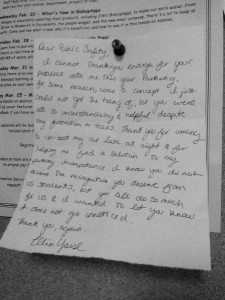By Taylor Stoudt
Transcript Reporter
The lonely gray building to the east of University Hall is receiving some love as donors express interest in its future.
University President Rock Jones said a particular donor started “preliminary conversations” about how to best use the building and “the resources available to fund its restoration.” He then formed a committee chaired by Dale Swartzentruber, associate dean for institutional research, to explore the university’s options for Merrick Hall. Swartzentruber presented details about the potential uses for the building were discussed at the faculty meeting on Feb. 11.
“A couple of months ago Rock (Jones) asked me to put together a task force of what turned out to be 17 faculty and staff, to come up with some ideas for the renovation of Merrick Hall should funds become available for that renovation,” Swartzentruber said.
The committee held two meetings. In the first, the group toured the building and was asked by Jones to compile a list of ideas that Ohio Wesleyan might want to execute and a donor would be excited about funding. In the second, the committee opened up two discussion groups, one for students and another for faculty and staff, to share ideas and hopes for the building.
“It was a consensus of the surveys and the committee that this proposal would essentially look at the building as a home for a students-centered approach to the curricular initiative for co-curricular as well as academic engagement,” Swartzentruber said.
In working with the idea of co-curricular engagement and a move towards academic excellence, Swartzentruber said it would be fitting if the building included space for the Office of Academic Advising, the Academic Resource Center, the Office of International Studies and Off-Campus Programming, and the Office of Career Services.
In addition to using the building as a student-centered space, there are hopes for classrooms in Merrick that would be shared among the different departments and groups looking for more space.
“What we do with the building has to be consistent with the school mission and the faculty has to feel comfortable with it,” Swartzentruber said. “But if a donor comes along and gives us however many millions of dollars we need then the donor has a lot to say with what we do with the building.”
Currently, the building consists of three floors and a basement. The first two floors are about 15 feet tall; the third is upwards of 20 feet. The building also houses a lecture hall with stadium seating divided into into two separate classrooms.
The basement could be made taller by digging further into the ground, and the walls currently dividing the floor into small offices could be removed to make it one large room.
“Virtually everyone agrees that that room should be opened up and used in all its majesty,” Swartzentruber said. “It could be a really nice space with the wooden beams that go the entire width of that top floor, and the tall windows are just beautiful. It’s an impressive space that, given the resources, I think we would all be very proud to make good use of.”
In the 20 years Swartzentruber has worked at Ohio Wesleyan, he has never seen the building used for university purposes.
“I think it’s a real shame to have a building in that location and that is that dominant and not have any use for it,” Swartzentruber said. “It’s a huge stone building made from stone from our local Blue Limestone quarry, but it’s very excit(ing) to think that there’s a good possibility that we’re going to be able to make use of it.”
The restoration of the building is estimated between $5 million and $10 million. The donor who expressed interest in the project wishes to remain anonymous.
“The only reason we’re not using it is because it would cost millions of dollars to make it useful,” Swartzentruber said. “And we’re functioning well without it. We just want to function better. So it’s not that we require the use of the building, but we’ll be a better school if we make good use of it.”
Jones said the university is currently “issuing a request for proposals” from design contractors that could be helpful in completing the project.
No university money has been spent.
“In the mean time, I’ll be having additional conversations with the individual who first proposed the question and we remain open to any and all input that the campus might have to share,” he said.
